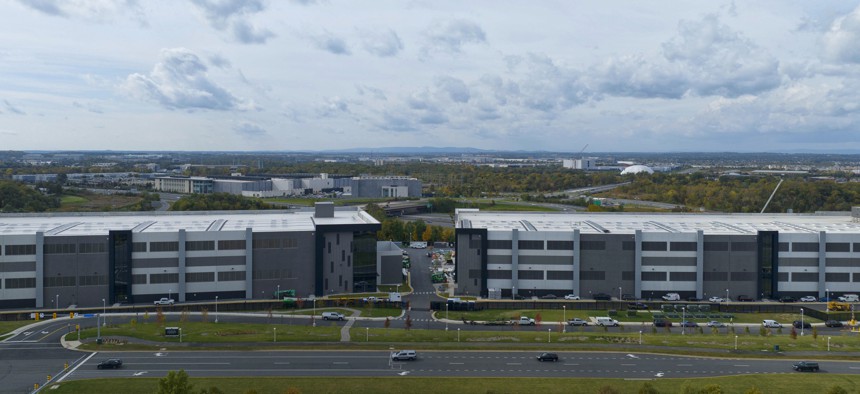Officials Tout Data Centers’ Economic Benefits

Data center in Sterling, Virginia. GettyImages/Gerville
Amazon said its facilities in Virginia paid more than $300 million in taxes last year alone, and local leaders said the campuses contribute to economic development.
It took just seven months from Intel announcing it would build two chip factories near Columbus, Ohio, to shovels going into the ground, an accomplishment that one state leader said was due to government at every level working together on acquiring the property, developing the infrastructure and amending the zoning.
Also a factor in making the location attractive, was Amazon Web Services’ investments in other data centers in that part of Ohio beginning in 2015, according to Pat Tiberi, a former U.S. representative and now the president and CEO of the Ohio Business Roundtable lobby group. The Columbus-area data centers sparked investment in infrastructure like power, water and sewage, created jobs and also provided internet connectivity to the area.
Columbus illustrates the wider economic impact of data centers that a bevy of AWS officials and elected leaders past and present touted this week at the AWS Summit in Washington, D.C. The company released new research showing its investment in data centers in Virginia topped $51 billion over a decade, with those facilities paying $334 million in business personal property taxes in 2022 across the commonwealth.
Between 2011 and 2021, the Virginia data centers supported over 7,000 full-time jobs at local businesses annually, Amazon said, and generated an estimated $8.2 billion in total gross domestic product for the commonwealth. The company announced in January it would spend an additional $35 billion to establish even more data centers in Virginia by 2040.
Given the continued advances in technology, the investment in data centers by AWS and its competitors is unlikely to slow down any time soon, experts on a panel during the summit said.
“We've had some folks around here … who have said, ‘Well, there's enough, it's going to slow down, we're over-investing in this area,’” said Terry Clower, a professor of public policy in the Schar School of Policy and Government at George Mason University. “What has been the No. 1 story the last few weeks about business? Nvidia, ChatGPT, artificial intelligence. Guess what all that is based on? Data. And where's that data stored and accessed? Data centers.”
For localities, one of the most attractive aspects of data center development is the effect they have on a jurisdiction’s tax base.
Victor Angry, a member of the Prince William County, Virginia, Board of Supervisors, said taxes on residential property stayed flat for the first time in a long time, even as public safety officials received a 15% pay bump and all other public employees received a 3% step raise. And under the county’s revenue-sharing agreement that dictates that 57.23% of every dollar received in taxes must go to public schools, Angry said the taxes paid by data centers have helped create a “world class school system.” He said data center development has also prompted a “huge shift” in the types of jobs available throughout the county.
Data center development has not been without its critics.
State and local tax incentives help attract data centers. Some states have exempted data centers from sales and use tax, and the incentives have made some lawmakers wary of giving away too much to the industry. Experts have suggested that rather than simply using tax incentives to attract businesses, they can be restructured to emphasize sustainable development.
Homeowners near data centers are raising concerns over quality of life issues. Prince William County’s approval last year of a framework that would convert 2,100 acres of rural land into a data center campus came under fire from residents concerned about noise, traffic and the environmental and historical impacts of development.
Those environmental impacts have forced some local governments to reconsider their desire to attract data centers, while power problems have also prompted others to further diversify their electricity sources.
Angry put much of the opposition to data centers down to misinformation that spreads among residents. Tiberi said it was similar in Ohio: Before the data centers there were built, he said, the projects were surrounded by “rumors and innuendos.”
Clower said while community concerns are legitimate, advances in data center technology and understanding where those facilities are built mean those issues are less worrisome. “But you see their concern,” he said. “We're getting much better at understanding what a buffer looks like for two different uses.”
Despite local governments’ enthusiasm for data centers as anchors that expand utility infrastructure and connectivity, Angry said Prince William County’s appetite to build will not last forever.
“It's like a wildfire,” he told reporters after the roundtable. “If you don't control it, then it can take over everything, and so we don't want to do that.”






